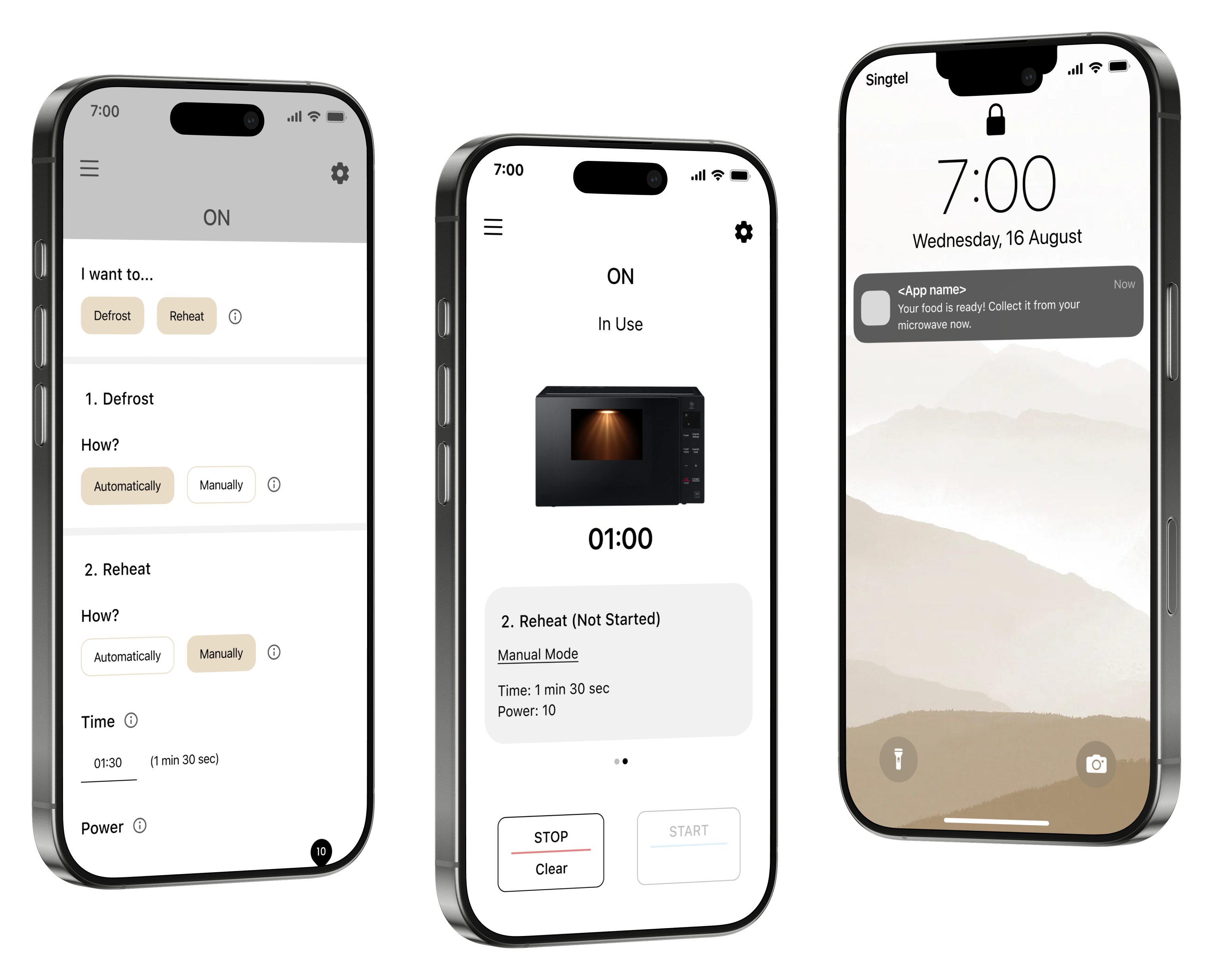
IoT Kitchen Assistant
Overview
The IoT Kitchen Assistant was a rapid, three-day project completed for Company X (name withheld due to NDA).
Understanding the Task
I began the project by mapping out actions needed for understanding the task at hand.
"Imagine you've been asked to design an app interface for a connected microwave, what might the app interface look like?"
App interface
Explore Company X's app
Connected microwave
Research traditional and smart microwaves
To acquire general knowledge about microwaves
Learnings
The following groundwork led to several learnings:
Company X's app
-
The app interface mimics actual Company X products
To adopt the same approach for Company X's microwave
Traditional microwaves
Uses
Functions
-
Defrost
-
Reheat
-
Roast
-
Grill
-
Boil
-
Steam
-
Blanch
-
Bake
-
Start
-
Stop / Clear
-
Time (X min X sec)
-
Power (Level 1-10)
-
Defrost
-
Reheat
-
Not all traditional microwaves provide such diverse uses. The basic uses are 'Defrost' and 'Reheat' while other uses allow for cooking.
As I don't have sufficient information about Company X's microwave, I'm unsure what uses it supports. These uses would affect what individuals are able to do within the app.
Smart microwaves
-
WiFi-based appliances, Able to control remotely via an app
Recognising the Challenge
A key challenge was the lack of information about Company X's product strategy and business goals. It was unclear whether Company X's microwave incorporated any proprietary technology or innovation that could affect the app's priorities and overall design direction. Without such knowledge, it was difficult to assess the kind of features Company X could support. I knew I would have to make assumptions about the app's priorities—something I would aim to clarify early on with stakeholders in a real-world setting.
Process
Using the Double Diamond framework to structure my design process and outline key activities for each phase
Discover phase:
-
User Research
Explore / Define phase:
-
Synthesis
-
Prioritisation
Develop / Test phase:
-
Wireframing & Prototyping
-
Testing*
-
Iteration*
Deliver phase:
-
Next Steps
*Due to time constraints, I wasn't able to carry out these activities
User Research
I conducted User Interviews with two individuals, each lasting approximately 30 minutes.
The Goal
-
To gather insights from users regarding their microwave usage
-
To discover needs and pain points with regards to existing traditional or smart microwave usage
-
To explore features for microwave usage through an app
Interview Guide
-
How often do you use a microwave?
-
What do you use a microwave for?
-
For _ with a microwave, what type of dishes do you prepare? (Repeat for each use)
-
Please describe your routine when you _ with a microwave. (Repeat for each use)
-
What do you think about it?
-
How do you feel about it?
-
-
How do you interact with the microwave's settings when you _ with a microwave? (Repeat for each use)
-
Is there anything you wish to do with a microwave that you currently aren't able to? Please explain.
-
In what ways do you think an app could improve your microwave usage? Please explain.
Synthesis
With insights gathered from the user research, I created a Value Proposition Canvas.
The Goal
-
To gain an understanding of users and ensure the app is positioned around their needs and pain points
-
To conceptualise features for the app
See Figma
Prioritisation
From there, I ranked features based on its importance using the MoSCoW method (Must Have, Should Have, Could Have, Won't Have).
The Goal
-
To manage time constraints - For a minimum viable product
-
To opt for features that provide a strong foundation for the app's functionality and usability
See Figma
Solution
The solution consists of all features under Must Have and some features under Should Have.
See Figma
Design decisions
Lets users know the microwave’s status
-
ON / OFF
-
In Use / Not In Use
To get started with the app, users are prompted to switch on the microwave if they have not done so. When not in use, they're reminded to switch off the microwave for safety and energy efficiency.
'i' icon provides more information to users so that they can make the right choice.
A button is enabled only when the microwave's settings are configured.
Next Steps
Given the tight, three-day timeline, I was able to deliver a first-pass design for the IoT Kitchen Assistant. Assuming I now have sufficient information about Company X's product strategy and business goals—and using the existing design as a baseline—I plan to carry out Usability Testing to assess usability and task completion.
Following which, I'll categorise feedback by severity and iterate on the design accordingly while liaising with stakeholders to ensure alignment with product vision and technical feasibility.
To prepare for handoff, I'll finalise design documentation and set up a feedback loop during implementation to address edge cases and technical constraints as it arise.
At post-launch, I'll collect additional feedback through in-app prompts and reviews from Apple App Store and Google Play Store. These insights will be shared with stakeholders to re-assess priorities and guide design updates for future releases.
Try it out!
See Figma













